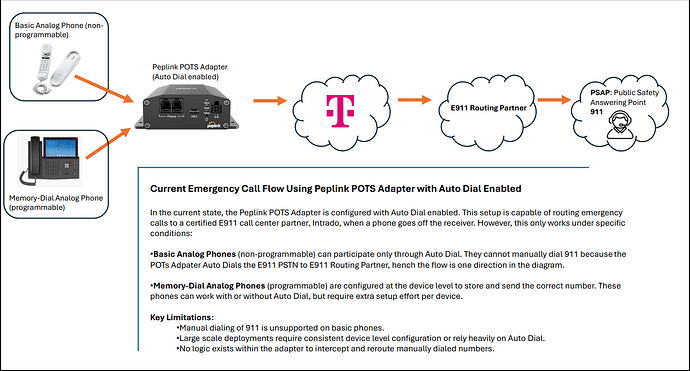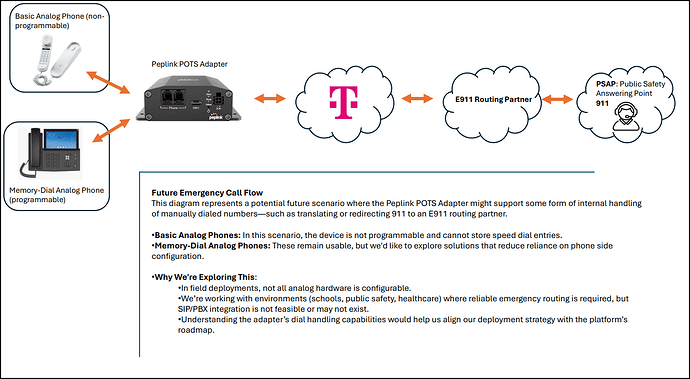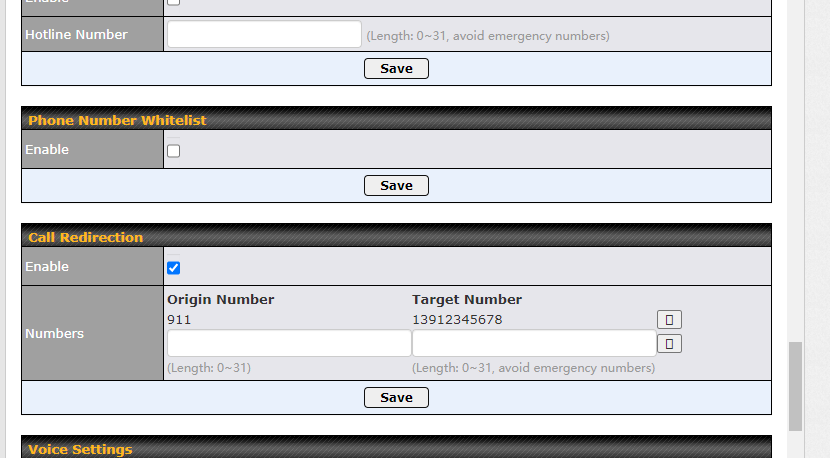Hi Peplink Team,
We’re currently conducting live field testing of the Peplink POTS Adapter across emergency communication deployments, including blue light phones and analog emergency lines in school and public safety environments. We’re also partnered with a certified E911 call center to ensure proper routing and regulatory compliance.
During testing, we identified a critical need for additional control over dial pattern handling, especially in environments without SIP, PBX, or VoIP infrastructure. Many of these locations still rely on basic analog phones that are not programmable, making it impossible to store custom dial strings or speed dials at the device level.
We’ve noted that the device already supports whitelisting of numbers, which suggests it has internal logic capable of evaluating dialed digits. We believe this capability could be extended to support basic dial translation functionality.
To provide context, we’ve attached a diagram outlining both current functionality and future considerations.
Requested Enhancement:
Custom Dial Translation Table
-
Allow translation of dialed patterns (e.g., translate 933 and 911 to prepend digits like 1800xxxxxxx to route calls to the E911 call center or other support lines when manually dialed, including 933, 911, or other specified numbers).
-
Support up to 5 translated dial rules to keep the configuration simple and manageable, without the need for SIP, PBX, or VoIP.
This enhancement would provide the flexibility needed to support deployments where analog phones cannot be reprogrammed and dial logic must be managed at the adapter level.
Please let us know if this feature is being considered for future firmware releases or if additional context would help. We’re happy to walk through our use case and testing setup in more detail.
Best regards,
Puma
1 Like
Hi Puma,
this sound interesting! Let’s continue discussion via e-mail. We will reach to you shortly.
1 Like
Hi Peplink Team,
BPA is very interested in this solution as well. We have sourced 2 of the Peplink POTS Adapters for testing as a 911solution in power substations as an alternative to copper facilities (which are becoming cost prohibitive). We have noted the limitation on LTE for passing E911 information and that’s an issue for us. We are wondering if you have any way for us to pass this info on the local PSAP. Thank you in advance for your reply.
Blake Dietze
Bonneville Power Administration
1 Like
Hi Blake,
we are working to get e911 certified with Verizon. Verizon allows to register your phone number (which is tied to POTS Adapter) in their internal systems. So once 911 is called, the Verizon can provide the location to PSAP.
Alternatively it would be possible to use call forwarding, which was described by Puma in the post above. We are working to add this feature in the future POTS Adapter Firmware release. In that particular case, the location is passed to PSAP by a 3rd party (e911 routing partner).
Thanks,
Giedrius
2 Likes
These are good moves. I’ll provide one real-world example (one I personally lived through) of why the “tie” to E911 is critical in some use cases.
The pertinent government code which regulates passenger elevator requires a phone which will directly reach a PSAP; location must be reported via the MSAG (caller ID or other means is not sufficient.) The elevator inspector comes to do his half-yearly inspection and tests the phone. He asks the PSAP employee what address is shown for the call. If the address is correct - pass; otherwise: fail. If fail, the owner is cited for a code violation.
2 Likes
Hi Everyone,
We’ve added the requested feature mentioned in the forum post. Below is a link to a test firmware (only for testing):
The new feature is named as Call redirection. Let us know your feedback 
1 Like
Hi @Giedrius , Any updates on the E911 Cert with VZW?
Appreciate your updates.
Hi Zakk,
we are in cert. progress and asking for a lab provide as timeline. Hard to say at this point how long it could take.
G.
1 Like
This actually pairs nicely with the likes of Intrado. Good work.
1 Like
@Giedrius, Is there any new information on this you could share regarding E911 support?
Hi Zakk,
The feature discussed in this forum topic will be supported officially in 1.1.5 Firmware release, which is coming soon. This will allow making 911 calls by using a third party service as described by Puma.
Additionally we are working with Verizon to get E911 certified on Verizon network. This is currently in progress.
G.
1 Like


